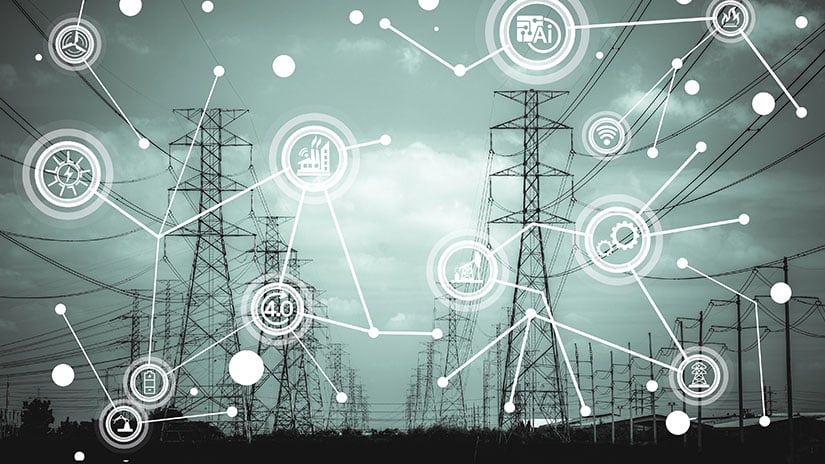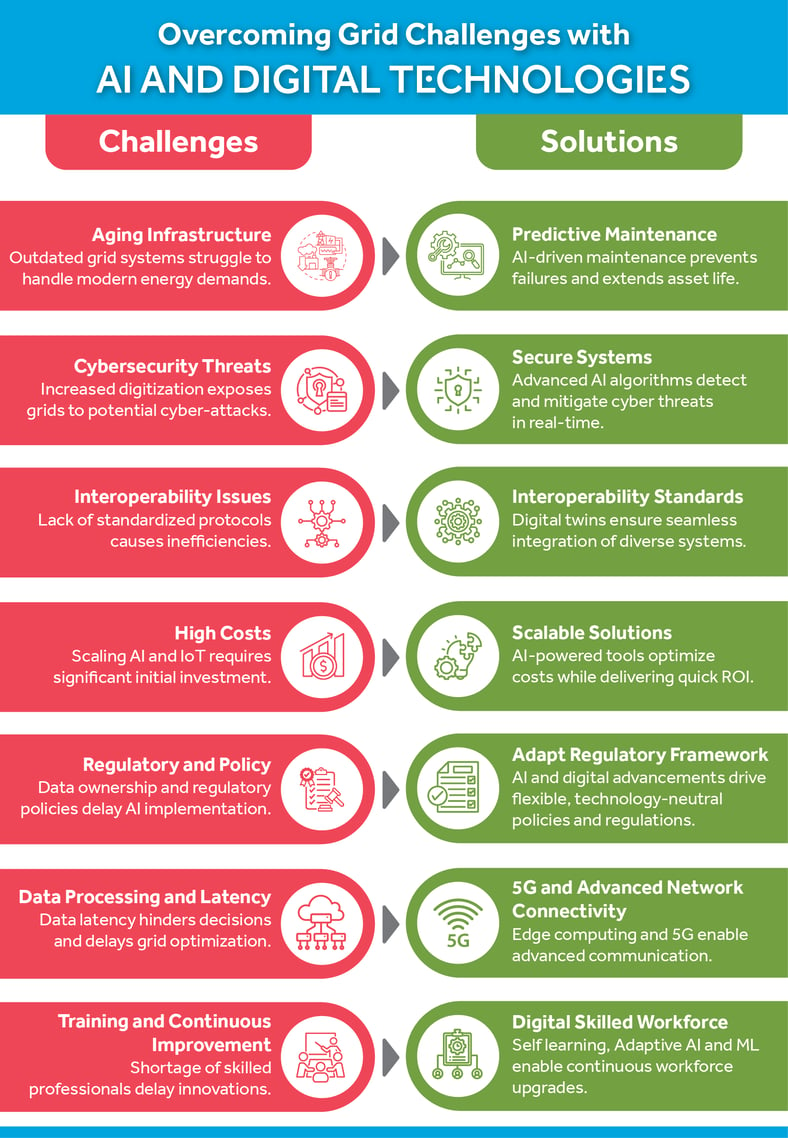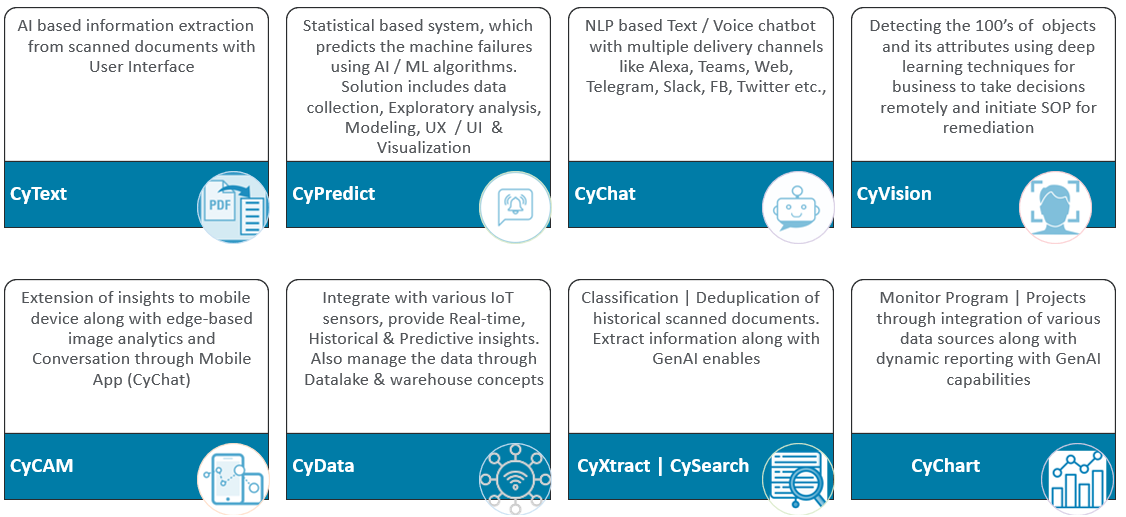Energy Grid Optimization- AI & Digital Technologies for Improving Efficiency
Written by Dnyandeo Baburao Shinde 24 Dec, 2024
Optimizing energy grids is imperative to meet the evolving needs of modern power systems, particularly as the world transitions toward sustainable energy sources and ambitious decarbonization goals. Artificial Intelligence (AI) and digital technologies are spearheading this revolution, transforming traditional grids into efficient, adaptive and highly resilient systems. These advancements facilitate the seamless integration of renewable energy, drive down operational costs, and significantly enhance energy reliability, ensuring grids are future-ready and capable of supporting a sustainable, low-carbon economy.
Why Energy Grid Optimization is Critical Today
The future of energy hinges on grid optimization as we face a 3% annual surge in global electricity demand through 2030, driven by booming cities and a skyrocketing EV market, poised to top 240 million vehicles. Meanwhile, renewable energy—now powering over 10% of the grid—is a game-changer with a catch: its variability demands smarter, more adaptive systems. Adding to the urgency, aging infrastructure (over 70% of U.S. transmission lines are past their prime) struggles under modern loads and distributed energy resources. The good news? Cutting-edge technologies like AI and digital twins are stepping up, promising to slash energy costs by 20% and emissions by up to 15%, paving the way for greener, smarter grids and a sustainable tomorrow.

Harnessing AI for Smarter Grid Management and Predictive Maintenance
- Real-Time Energy Demand Prediction: AI algorithms analyze historical data, weather patterns, and user behavior to forecast energy demand with high accuracy. These forecasts enable utilities to dynamically adjust supply through smart grid technologies and operational strategies, reducing energy waste and ensuring efficient resource allocation.
- Predictive Maintenance for Critical Components: Machine learning models analyze sensor data from critical components such as transformers, cables, and circuit breakers to detect early signs of potential failures. By identifying issues before they escalate, AI-driven maintenance reduces outages, prolongs equipment lifespan, and significantly lowers the costs associated with unplanned repairs.
- Strengthened Grid Security: AI algorithms continuously monitor and analyze vast datasets from network, system logs, and grid sensors to detect anomalies that may indicate cyber-attacks or physical vulnerabilities. These insights allow for proactive intervention, bolstering the resilience of the grid against evolving security threats.
- Optimized Grid Performance: Leveraging AI’s ability to analyze real-time data from sensors and weather forecasts, energy providers can achieve enhanced grid performance, adapting to fluctuating conditions with unparalleled efficiency.
This combination of predictive analytics, operational optimization, and enhanced security makes AI an indispensable tool for modernizing energy grids to meet the demands of a sustainable energy future.
Digital Twins: Revolutionizing Real-Time Monitoring and Simulation
Digital twins represent virtual replicas of physical grid assets, are transforming energy management by providing a real-time, comprehensive view of the system behaviour. These advanced models enable operators to monitor equipment health, analyze load distribution, and optimize system performance with remarkable precision allowing for swift adjustments to maintain operational efficiency. Beyond monitoring, digital twins simulate various scenarios—such as demand surges, equipment failures, or extreme weather conditions – empowering grid operators to anticipate impacts, make informed decisions, and enhance overall efficiency.
In addition to bolstering grid stability, digital twins facilitate the seamless integration of renewable energy by modelling the variability of sources like solar and wind, predicting output fluctuations, and allocating resources accordingly. With predictive capabilities, they also enable utilities to address potential issues before they escalate, minimizing downtime and maximizing efficiency. Digital twins are redefining grid operations, driving the energy sector toward a future of unparalleled reliability and sustainability.
Smart Grids and IoT: Elevating Grid Connectivity and Insights
The Internet of Things (IoT) has revolutionized energy grids by introducing a vast network of sensors and smart devices that collect and transmit real-time data. This enhanced connectivity transforms grid efficiency by enabling precise, responsive adjustments and providing detailed insights into system performance. For instance, smart meters track energy usage with accuracy, offering invaluable insights into consumer demand patters. This not only facilitates more effective load balancing and dynamic pricing but also empowers consumers to monitor energy consumption and costs in real time.
IoT technologies further enable demand response programs, encouraging users to reduce energy consumption during peak periods. This reduces strain on the grid during peak periods, redistributes energy more effectively, and minimizes the need for costly infrastructure upgrades. Additionally, innovations like edge computing enhance the grid’s responsiveness by processing data closer to the source, allowing for rapid adjustments to dynamic conditions and efficient management of distributed energy resources (DERs).
Decentralization and Distributed Energy Resource Management (DERM)
Distributed energy resources (DERs), including rooftop solar panels, microgrids and electric vehicles (EVs) are revolutionizing energy grids by transitioning them from centralized systems to highly decentralized and dynamic networks. These shifts demand advanced AI and digital technologies to manage the growing complexity and ensure operational efficiency.
DERMS software plays a pivotal role in optimizing DERs, enabling utilities to balance local energy supply and demand, seamlessly. This reduces strain on the grid, minimizes transmission losses, and improves overall system reliability. EVs with vehicle-to-grid (V2G) technology, act as mobile energy storage units- discharging power back into the grid during peak demand and charging during off-peak hours. AI algorithms effectively manage V2G interactions, balancing charging schedules, battery health, and grid demand to ensure optimized energy flow. Microgrid operations also benefit from AI-driven solutions, which dynamically balance renewable energy supply with community demand, reducing costs and improving reliability.
Renewable Energy Forecasting and Storage Optimization
The variable and intermittent nature of renewable energy sources like wind and solar introduces challenges to grid stability. AI and digital tools provide a transformative solution by forecasting renewable energy production with remarkable accuracy and optimizing energy storage systems.
AI algorithms analyze weather patterns, historical generation data, and satellite imagery to predict renewable energy production. These forecasts enable grid operators to anticipate fluctuations in energy output and adjust other resources, accordingly, maintaining grid balance. Advanced battery management systems, powered by AI, optimize when and how storage assets are charged or discharged, considering forecasted demand, renewable output, and market conditions. By balancing input and output from multiple energy resources, AI ensures the smooth operation of the grid and maximizes the efficiency of renewable energy utilization.
Decarbonization and Emission Reduction through Smart Grids
AI and digital technologies are driving global decarbonization efforts by streamlining the transition to cleaner energy sources and reducing emissions. AI algorithms evaluate the environmental impact of various energy sources in real-time prioritize cleaner options during low-demand periods. Smart grid systems, supported by digital technologies, enable precise tracking and reporting of emissions, empowering utilities to meet stringent regulatory requirements while maintaining transparency.
By integrating renewable energy, optimizing storage, and enhancing grid operations, AI and digital tools are not only transforming the energy landscape but also propelling the world closer to its decarbonization and sustainability goals.
Challenges in Implementing AI and Digital Technologies in Energy Grids
In the journey toward modernizing energy grids, various challenges stand in the way of achieving efficiency, reliability, and sustainability. From aging infrastructure to cybersecurity vulnerabilities, these obstacles can seem daunting. However, advancements in Artificial Intelligence (AI) and digital technologies provide innovative solutions to overcome these hurdles. This infographic highlights key challenges faced by energy grids and the corresponding AI-driven and digital solutions that are transforming the energy landscape. Explore how predictive maintenance, secure systems, interoperability standards, scalable solutions, regulatory policies, latency in data collection and workforce training are paving the way for a smarter, more resilient energy future.

Cyient’s Capability on AI and Digital Technologies
Cyient leverages multiple digital accelerators and integrates AI for data extraction, data predictions for assets failures, integration of various IoT services, usage of Gen-AI capabilities in dynamic reporting for utilities.

Conclusion
AI and digital technologies are no longer optional in energy grid optimization, they are essential for crafting a resilient, efficient, and sustainable energy ecosystem. By enabling predictive maintenance, demand forecasting, renewable energy system and distributed energy resource management (DERM), these technologies are revolutionizing how energy grids operate. They empower utilities to not only address immediate challenges such as rising energy demand and infrastructure vulnerabilities but also to align with long-term sustainability goals.
As we transition into a green economy, these innovations pave the way for energy grids that are adaptive, reliable, and future-ready. The integration of these advanced technologies will not only ensure seamless operations but also foster the global shift toward decarbonization and a cleaner energy future. With the right investments and strategies, the energy grid of tomorrow is within reach today.
About the Author

Dnyandeo Baburao Shinde, Subject Matter Expert, Utilities
Dnyandeo Baburao Shinde is a seasoned GIS professional with expertise in the Utilities domain, currently serving as a Subject Matter Expert for Utilities in the Competency Development Team. With extensive experience in GIS projects, including data conversion, migration, and conflation for utilities, he brings deep knowledge in project management, execution, and data analysis. Dnyandeo is also adept at delivering technical training on industry-leading tools such as Esri UNM, ArcGIS Pro, Smallworld, ArcMap, AutoCAD, and QGIS, showcasing his proficiency in driving technical excellence and upskilling teams.
.png?width=774&height=812&name=Master%20final%201%20(1).png)